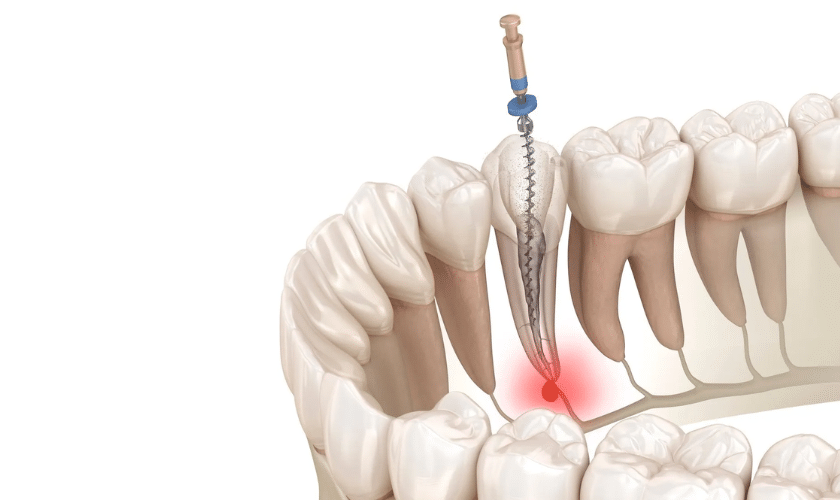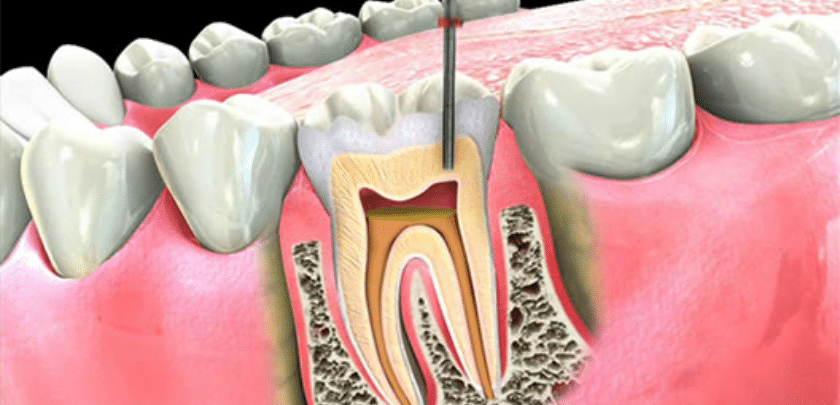
August 14, 2024
Tooth pain can be one of the most distressing experiences, especially when it lingers and disrupts your daily life. While some might brush it off as a minor inconvenience, persistent tooth pain or sensitivity often signals something more serious—potential damage to the pulp inside your tooth. Ignoring these signs can lead to severe infections and even tooth loss, making timely intervention critical. Root canal treatment, though often misunderstood, can be the solution that saves your tooth and alleviates the pain. Curious to know if your symptoms might require a root canal? Read on to discover the signs you shouldn’t ignore and how this treatment can preserve your smile.
What Is Root Canal Treatment?
Root canal treatment is a dental procedure that focuses on treating the infected or damaged pulp within a tooth. This treatment is essential for preserving the natural tooth and preventing further complications, such as abscesses or tooth loss. Many people fear root canals due to outdated misconceptions, but modern techniques make the procedure much less painful and invasive than ever before.
Root canal treatment involves cleaning out the infected pulp, disinfecting the root canals, and sealing the tooth to protect it from future infections. While the idea of a root canal might seem intimidating, it is often the best way to save a tooth that would otherwise need to be extracted. This treatment helps maintain your natural smile and allows you to continue enjoying your favorite foods without discomfort.
The Anatomy of a Tooth
Understanding why root canal treatment is necessary requires knowing the structure of a tooth. Each tooth consists of several layers: enamel, dentin, and pulp. The enamel is the hard outer layer, while the dentin is the softer layer beneath it. The pulp, located at the core of the tooth, contains nerves, blood vessels, and connective tissue.
When the pulp becomes infected or damaged, it can cause severe pain and lead to more significant issues if not treated promptly. Root canal treatment is designed to remove the infected pulp while preserving the tooth’s structure, allowing you to avoid extraction and retain your natural tooth.
Common Causes of Pulp Damage
Several factors can contribute to pulp damage, making root canal treatment necessary. These causes include:
Deep Decay
One of the most common reasons for pulp damage is untreated tooth decay. When cavities go untreated, they can penetrate the enamel and dentin layers, eventually reaching the pulp. Once the pulp is infected, the only way to save the tooth is through root canal treatment. Ignoring the decay can lead to abscesses and tooth loss.
Trauma to the Tooth
Physical trauma, such as a blow to the mouth, can also damage the pulp, even if there are no visible cracks or chips in the tooth. This type of injury can cause inflammation and infection within the pulp, necessitating a root canal to save the tooth. It’s essential to seek dental care after any injury to the mouth, as the damage may not be immediately apparent.
Repeated Dental Procedures
Teeth that have undergone multiple dental procedures, such as fillings or crowns, can become weakened over time. The repeated work can irritate the pulp, leading to inflammation and infection. In such cases, root canal treatment may be required to address the underlying issue and prevent further damage.
Cracks and Chips
Cracks and chips in teeth can expose the pulp to bacteria, leading to infection. While some cracks may be minor and not cause immediate concern, deeper cracks can compromise the tooth’s integrity and lead to pulp damage. Root canal treatment is often necessary to remove the infected pulp and restore the tooth’s strength.
Gum Disease
Severe gum disease can also affect the pulp, as bacteria can spread from the gums to the roots of the teeth. In advanced cases, the infection can reach the pulp, making root canal treatment necessary to prevent tooth loss. Maintaining good oral hygiene and addressing gum disease early can help prevent this outcome.
Key Signs That Root Canal Treatment Is Needed
Recognizing the signs of pulp damage is crucial for seeking timely treatment. Here are the key symptoms that may indicate the need for a root canal:
Persistent Tooth Pain
Tooth pain is one of the most common indicators that something is wrong with the pulp. The pain may be constant or intermittent, but it typically worsens when you bite down or apply pressure to the affected tooth. If the pain persists for more than a few days, it’s essential to see a dentist as soon as possible.
Sensitivity to Hot and Cold
Increased sensitivity to hot and cold foods or drinks can also signal pulp damage. If the sensitivity lingers long after you’ve finished eating or drinking, it may be a sign that the pulp is inflamed or infected. This symptom should not be ignored, as it often indicates that a root canal may be necessary.
Swollen or Tender Gums
Swelling or tenderness in the gums around the affected tooth can indicate an underlying infection. This swelling may be accompanied by a small bump or abscess on the gums. If left untreated, the infection can spread to other areas of the mouth, making root canal treatment essential.
Discoloration of the Tooth
A tooth that becomes discolored, typically turning gray or dark brown, may have damaged or dying pulp. This discoloration occurs because the pulp’s blood supply is compromised, leading to tissue death. Root canal treatment can help save the tooth and restore its appearance.
Prolonged Tooth Sensitivity
If your tooth remains sensitive long after exposure to heat or cold, it could be a sign of nerve damage within the pulp. This type of sensitivity often signals that the pulp is inflamed or infected, requiring root canal treatment to prevent further damage.
Bad Breath or Taste
Persistent bad breath or an unpleasant taste in your mouth can be a sign of an infected tooth. The bacteria causing the infection can produce foul-smelling odors, which may be noticeable even after brushing and flossing. If you experience these symptoms, it’s essential to seek dental care promptly.
Pimple on the Gums
A small, recurring pimple or bump on the gums near the affected tooth can indicate an abscess. This bump may release pus, which is a sign of infection. If you notice this symptom, it’s crucial to see a dentist Geneva for evaluation, as a root canal may be needed to treat the infection and save the tooth.
Loose Tooth
If a tooth feels loose, it could be a sign of advanced infection that has affected the surrounding bone structure. Root canal treatment may be necessary to remove the infection and stabilize the tooth, preventing further complications.
How Root Canal Treatment Saves Teeth
Root canal treatment is a highly effective way to save a damaged or infected tooth. During the procedure, the dentist removes the infected pulp, cleans and disinfects the root canals, and seals the tooth with a filling or crown. This process eliminates the infection, prevents further damage, and restores the tooth’s function.
The Role of Modern Technology
Advances in dental technology have made root canal treatment more comfortable and efficient than ever before. High-quality imaging allows dentists to accurately diagnose pulp damage, while specialized tools enable precise cleaning and shaping of the root canals. As a result, the procedure is typically quick and relatively painless, with most patients experiencing only mild discomfort afterward.
Recovery and Aftercare
After root canal treatment, it’s essential to follow your dentist’s instructions for recovery and aftercare. This may include taking prescribed medications, avoiding certain foods, and maintaining good oral hygiene. With proper care, the treated tooth can last a lifetime, allowing you to enjoy a healthy smile for years to come.
Preventing the Need for Root Canal Treatment
While root canal treatment is an effective solution for damaged or infected teeth, preventing the need for the procedure is always the best approach. Here are some tips to help you protect your teeth and avoid root canals:
Maintain Good Oral Hygiene
Brushing and flossing regularly are essential for preventing tooth decay and gum disease, both of which can lead to pulp damage. Use fluoride toothpaste and a soft-bristled toothbrush to clean your teeth thoroughly, and don’t forget to brush your tongue and the roof of your mouth.
Visit Your Dentist Regularly
Regular dental check-ups are crucial for detecting and addressing issues before they become severe. Your dentist can spot early signs of decay, cracks, or gum disease, allowing for prompt treatment that can prevent the need for root canal therapy. Aim to visit your dentist at least twice a year for cleanings and exams.
Wear a Mouthguard
If you participate in contact sports or activities that could result in a blow to the mouth, wearing a mouthguard is essential. A custom-fit mouthguard can protect your teeth from trauma, reducing the risk of pulp damage and the need for root canal treatment.
Address Cavities Early
If you notice a cavity forming, don’t wait to have it treated. Early intervention can prevent the decay from reaching the pulp, eliminating the need for more extensive treatments like root canals. Fillings and sealants can effectively protect your teeth from further damage.
Avoid Chewing Hard Objects
Chewing on hard objects like ice, pens, or hard candies can cause cracks and chips in your teeth, exposing the pulp to infection. Avoid these habits and stick to softer foods that won’t put undue stress on your teeth.
When to See a Dentist
If you’re experiencing any of the symptoms mentioned above, it’s essential to see a dentist as soon as possible. Early intervention can save your tooth and prevent more severe complications down the line. Ignoring these signs can lead to increased pain, infection, and even tooth loss.
A dentist can evaluate your condition and determine whether root canal treatment is necessary. If caught early, the procedure can be quick and relatively painless, allowing you to return to your normal routine with minimal disruption.
Understanding when root canal treatment is necessary is crucial for maintaining your dental health. Persistent tooth pain, sensitivity, swelling, and discoloration are all signs that shouldn’t be ignored. Root canal treatment can save your tooth and restore your smile, preventing more serious issues in the future.
If you’re experiencing any of these symptoms, don’t hesitate to reach out to your dentist. They can assess your situation and recommend the best course of action. For those in Geneva, seeking prompt care can make all the difference in preserving your dental health. Root canal treatment in Geneva is available to ensure you receive the care you need.






